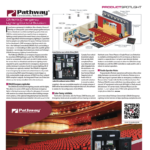Today’s CAD packages have — and this is perhaps an understatement — a lot of power beneath their hoods. An industry-standard drafting suite like Vectorworks or WYSIWYG costs thousands of dollars, not only in up-front costs but also in ongoing update and maintenance fees. For this, they provide a stunning array of features that — when used to their fullest extent — give the user a great deal of power. Learning to harness this potential, however, comes at the cost of a steep learning curve, many hours in training or searching through tutorials looking for the exact function one needs. The creators of Drafty thought this was unacceptable; that between ease of use and overbearing sophistication lay a realm of software usability begging for our acquaintance. And thus, Drafty was born.
Internet-Based
Unique among current software that provides similar functionality, Drafty runs entirely within your Internet browser. There are no DVDs to swap during a long install process or USB dongles to hunt around for or lose — just visit the web page and go. Currently, only Safari and Chrome are supported browsers. This is a touch disappointing for a die-hard Firefox fan like myself, but the developers say that Firefox support is forthcoming.
Navigating to the Drafty page in your browser, you are presented with an empty plot with a centerline and plasterline. The application helpfully fills in several industry-standard title boxes, including a symbol key, generic engineering disclaimer, designer name and contact, scale, etc. The right-hand toolbar contains most of the application’s main functions, such as layer controls, object and drawing toolbars, project controls and file save / import / export functions, while the bottom part of the screen is a context-sensitive menu that changes depending on the currently-selected object.
How it Works
Drawing in Drafty is easy once you understand the program’s simplified approach to drafting. While the application lacks some of the more esoteric features found in other programs, it makes up for it with a more streamlined workflow and less time spent hunting through functions you don’t need. Placing objects in Drafty is done with the right-hand toolbar, and these buttons all use the modifier keys (Alt, CTRL, shift and Command / Win Key) to access additional functionality of these controls. For instance, hold down Command and the “ERS” button becomes the “Mover” button. Hold down Shift and it inserts a PAR64 luminaire instead.
Once inserted, objects can be modified with the context menu at the bottom of the screen. Selecting an object allows you to enter manual X/Y positions, rotational data, set the model of moving lights, change the color of an object and more. Drafty uses a fixed layer set, and each object that you create will automatically assign itself to a layer based on what class of object it is. For instance, if you add a light while on the Scenic layer, Drafty will automatically move it to the Units’ layer. All scenic objects, from basic rectangles to chairs, automatically appear on the Scenic layer. This is a nice feature, and it helps keeps things organized — no more having to double back and clean up your drawing when you realize that you put several objects on a layer you didn’t want.
Navigation-wise, only objects on the currently-selected layer can be moved or interacted with. Adding multiple lights quickly is a snap, with convenient duplication functions. The units automatically inherit their position name and number themselves sequentially based on their position on a pipe or truss, though of course you can add channel numbers, as well as gels colors, scrollers, top hats and other accessories.
Just Select and Rotate
It’s hard to overstate how intelligent the designers have made this application. Simple operations like rotating lights that are snapped to a pipe or truss works the way one imagines it should — just select them and rotate. The lights will rotate around their individual center points on the pipe, instead of rotating around the center of the group, forcing the user to rotate them individually. Move that same pipe without selecting the lights first and the lights move with it, without having to manually group them together first. Select a group of units and click “Mirror” and get exactly that — a mirror-image group; no further work required.
Beyond Lighting and Sets
While primarily aimed at lighting and set paperwork, Drafty has some additional features that will make it attractive to both sound and video people: rack layout and workflows, which function as diagram tools to help technicians and designers visualize and design signal flows. These work in much the way you might expect: a box with symbols to represent inputs and outputs that the user can draw lines to connect inputs and outputs to, and label them accordingly. The rack designer works similarly, allowing the user to import drawings of their rack units and place them. There’s a lot of functionality here, and I recommend reading the Getting Started guide on the Drafty web site for a more in-depth discussion of the capabilities of these tools.
The biggest limitation Drafty has is that the application itself resides on the Internet, and without a connection to the Internet, the save and open functions will not be available. That said, once the program is cached in the browser, you will still be able to draw and continue without interruption when the network connection is reestablished.
Ultimately, Drafty strives to balance usability and power and presents itself as an effective solution for people who need to get things done quickly with a minimum of fuss while remaining affordable. It isn’t a program to do everything; it’s a program to accomplish essential paperwork in a streamlined and elegant package.
Quick, Intuitive and Cheap
For those daunted by the cost, learning curve and complexity of full-fledged software suites like Vectorworks or WYSIWYG, Drafty has emerged as an Internet-based alternative. While lower in cost and easier to master, Drafty software doesn’t pretend to compete head-on with those industrial strength alternatives. And one of its greatest strengths — Internet availability — also poses some limitations for those who’d prefer to take their laptop “off the grid” and work offline (although it will work, to an extent, offline). For users with Internet access who are looking to get things done quickly with a minimum of fuss, however, Drafty may be just the ticket.
Prices vary depending on package and subscription option. Drafty can be viewed and downloaded at www.drafty-app.com.


